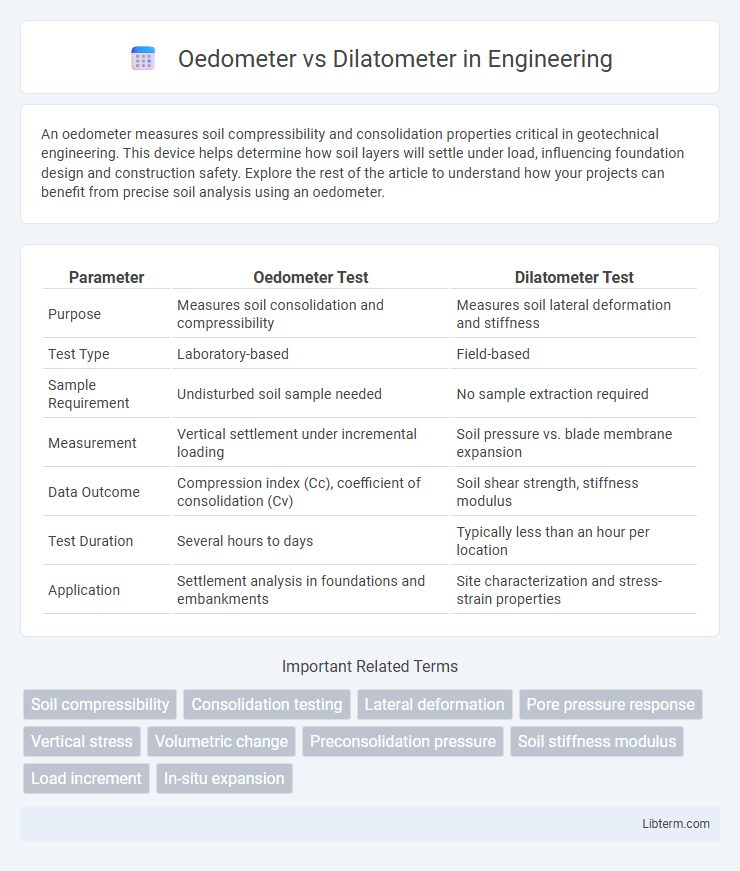An oedometer measures soil compressibility and consolidation properties critical in geotechnical engineering. This device helps determine how soil layers will settle under load, influencing foundation design and construction safety. Explore the rest of the article to understand how your projects can benefit from precise soil analysis using an oedometer.
Table of Comparison
| Parameter | Oedometer Test | Dilatometer Test |
|---|---|---|
| Purpose | Measures soil consolidation and compressibility | Measures soil lateral deformation and stiffness |
| Test Type | Laboratory-based | Field-based |
| Sample Requirement | Undisturbed soil sample needed | No sample extraction required |
| Measurement | Vertical settlement under incremental loading | Soil pressure vs. blade membrane expansion |
| Data Outcome | Compression index (Cc), coefficient of consolidation (Cv) | Soil shear strength, stiffness modulus |
| Test Duration | Several hours to days | Typically less than an hour per location |
| Application | Settlement analysis in foundations and embankments | Site characterization and stress-strain properties |
Introduction to Oedometer and Dilatometer
The oedometer measures soil compressibility and consolidation by applying vertical loads to a confined soil sample, providing essential data for foundation design and settlement analysis. The dilatometer test (DMT) evaluates soil stiffness and in-situ stress by inserting a flat blade with a membrane into the ground and measuring the pressure needed to expand the membrane, offering valuable information on soil stratigraphy and mechanical properties. Both devices are fundamental in geotechnical engineering for assessing soil behavior under load but differ significantly in testing methodology and the type of data obtained.
Fundamental Principles of Oedometer Testing
Oedometer testing measures soil compressibility by applying incremental vertical loads to a confined soil sample, restricting lateral strain to simulate one-dimensional consolidation. The test records time-dependent deformation under controlled loading, allowing determination of consolidation parameters such as compression index, coefficient of consolidation, and preconsolidation pressure. This fundamental principle is essential for evaluating settlement characteristics and designing foundations in geotechnical engineering.
Key Concepts in Dilatometer Testing
Dilatometer testing involves measuring soil deformation and stiffness by inflating a flat blade within a borehole to assess horizontal stress and strain properties, providing detailed insights into soil behavior under load. Unlike the oedometer test, which primarily evaluates vertical compressibility and consolidation properties under one-dimensional loading, the dilatometer captures in-situ lateral soil response and shear modulus. Key parameters obtained from dilatometer testing include the corrected pressure readings (DMT index), pore pressure measurements, and soil modulus estimations, which are essential for geotechnical design and soil characterization.
Historical Development and Evolution
The oedometer, first developed by Casagrande in the early 20th century, revolutionized soil compressibility testing by enabling precise measurement of one-dimensional consolidation properties, becoming foundational in geotechnical engineering. The dilatometer, introduced by Marchetti in the 1980s, offered a significant evolution with in-situ soil stiffness and strength assessment, enhancing field characterization without disturbing samples. Advances in digital data acquisition and sensor technology have continuously improved the accuracy and usability of both instruments, cementing their roles in modern site investigation and foundation design.
Equipment and Test Procedures
Oedometer tests use a rigid cylindrical specimen confined laterally, where vertical loading is applied incrementally to measure soil consolidation and compressibility. Dilatometer tests employ a flat blade with an inflatable diaphragm inserted into the soil to record pressure measurements during continuous penetration, providing in-situ soil stiffness and strength data. Equipment for oedometer tests typically includes loading frames and porous stones, while dilatometers require a membrane, pressure gauge, and penetrometer rig for field deployment.
Applications in Geotechnical Engineering
Oedometers are primarily used in geotechnical engineering to determine soil compressibility and consolidation properties essential for foundation design and settlement analysis. Dilatometers provide in-situ measurements of soil stiffness, lateral stress, and shear strength, facilitating site characterization and soil behavior assessment without sample disturbance. Both instruments are critical for evaluating soil mechanical properties, with oedometers suited for laboratory testing and dilatometers offering efficient field testing capabilities.
Advantages and Limitations of Each Method
The oedometer test provides precise measurement of soil compressibility and consolidation characteristics, making it ideal for predicting settlement in fine-grained soils but is limited by its small sample size and time-consuming procedure. The dilatometer test offers rapid in-situ assessment of soil strength, stiffness, and expansion properties across different depths, allowing for broader site characterization but may deliver less detailed data on soil consolidation behavior compared to laboratory oedometer testing. Choosing between these methods depends on the specific geotechnical project requirements, balancing the need for detailed laboratory analysis against efficient field profiling.
Comparison of Accuracy and Efficiency
Oedometers provide highly accurate measurements of soil consolidation characteristics by simulating one-dimensional consolidation, making them essential for precise settlement analysis. Dilatometers offer efficient in-situ testing that captures soil stiffness and deformation properties quickly, reducing field time and disturbance but with slightly less accuracy compared to laboratory oedometer tests. Combining both methods enhances geotechnical investigations by balancing the oedometer's detailed accuracy and the dilatometer's rapid efficiency in soil behavior assessment.
Typical Results and Data Interpretation
Oedometer tests provide precise consolidation parameters such as the coefficient of consolidation (Cv), compression index (Cc), and preconsolidation pressure (s'p), which are essential for settlement analysis in cohesive soils. Dilatometer tests yield continuous profiles of soil stiffness and in-situ horizontal stress, often expressed by the dilatometer modulus (Ed) and the dimensionless material index (ID), enabling assessment of soil stratigraphy and stiffness variations without sample disturbance. Data interpretation from oedometer tests focuses on time-dependent settlement and soil compressibility, while dilatometer results emphasize spatial variability and immediate stiffness characteristics, making them complementary tools for geotechnical site characterization.
Choosing the Appropriate Test for Your Project
Selecting between an oedometer and a dilatometer test depends on your project's specific geotechnical requirements and soil conditions. Use an oedometer test to determine soil consolidation properties and settlement predictions, especially for clayey soils, while a dilatometer test offers in-situ measurements of soil stiffness, strength, and stratification ideal for heterogeneous ground. Accurate interpretation of results from each test enhances foundation design, excavation support, and earthworks stability assessments.
Oedometer Infographic

 libterm.com
libterm.com